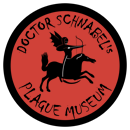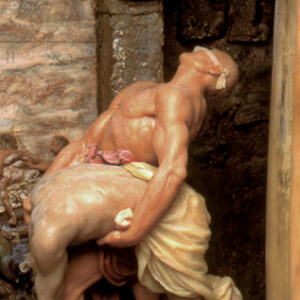Symbol of defense, deceit and diversion
Art vs reality
Countless paintings and prints remind us of the times when the plague was everywhere. However, these works of art rarely depict the disease itself, i.e. its symptoms. Such a level of realism was deemed too repulsive, where art was meant to exude beauty, or the view of miserable and dying people would spoil the effect when the purpose of a painting was to glorify the triumph over the epidemic. Nonetheless, the subject needed to be recognizable, and to this end a set of visual elements – symbols, gestures, personifications – developed through time, the presence of a few people with a cloth tied to their face being one of them. In general, these people are extras such as carriers or corpse collectors and not the VIPs.
On the flip side, the foul smell that came with the disease was so unpleasant that it’s probable that many more people wore cloths, soaked in vinegar or otherwise, wrapped around their heads than what these artworks show, the artist only having left them out for aesthetic considerations.
Therefore, the presence of a person wearing such a cloth in an artwork shouldn’t necessarily be seen as an accurate portrayal of a historic phenomenon. Similarly, the absence of cloths doesn’t necessarily mean that people didn’t commonly shield their faces in huge numbers.

Masks for protection
Covering the nose and mouth comes natural in any profession where people have to cope with stench, dust, smoke or poisonous vapors. But wearing a mask constantly was found bothersome, which may sound familiar to some of us, and life expectancy was not yet the issue that it is today.
When it comes to plague, the people that did tie a soaked cloth to their face were those engaged in hands-on tasks, like corpse collectors, who were often convict laborers. Hired grave diggers and volunteers reportedly wore special garments as well. Their masks or hoods could be crafted from materials like waxed cloth or leather, incorporating eye-holes.
Many physicians and health authorities advised against the use of full-face masks by doctors though. The sight of such an eerie figure could potentially shock patients who were already weakened, leading to a reaction so intense that they were more likely to succumb. In this case, the curist could be worse than the disease itself.

The closed hoods that were worn by lay brothers of confraternities in Italy and southern France, and how plague workers adopted this habit, are discussed in our Costume department.



Masks for pleasure
Rome was in the seventeenth century the capital of carnival, and when it was carnival, the courtyards and campi were cramped with caricaturesque clinicians and quacks.
These quacks, or ciarlatani (charlatans) as they were named, traditionally used masks as a part of their act to sell their precious potions. Sometimes they parodied learned doctors with corresponding masks. Comedians performed as charlatans and as doctors during carnival. Carnival goers dressed themselves up as doctors with masks. And carnival goers dressed up as charlatans playing doctors with masks. So it’s not always clear at first sight who these extravagantly dressed doctor-types are that we see on a depiction of carnival festivities. It does illustrate however, that when doctors with masks show up, it’s for laughs.

Equally ridiculous are the doctors of the commedia dell’arte. Like their carnival colleagues they are the opposite of what they pretend to be: egotistic and idiotic instead of learned and distinguished. The commedia dell’arte, carnival and other masquerades emerged into their own art genre, showing humorous fantasies of exuberantly dressed stock characters in all kinds of situations, popular not in the least for their hardly camouflaged erotic caliber. The hats of the doctors grew bigger and bigger, their intentions viler and viler, their noses longer and longer. Spectacles have since their invention been associated with satire; especially spectacles upon a big-nosed mask were the summum of saucy, and in the seventeenth century this was as easily understood as the eggplant emoji today.



Symbolic masks

Seventeenth century prints can be ambiguous to a level that makes them difficult to understand by present day viewers. They often hide layers of meanings and references that point to a moralistic content, leaving it in the middle if the displayed behaviour or intentions should be enjoyed or condemned. And there is no symbol that fits in with this ambiguity so well as the mask. Like the print itself covers its message by an everyday subject, it’s the depicted people, deities or personifications, who aim to hide their true purposes or identities behind a mask.




The mask of the plague doctor
Masks are inherently ambiguous: they both conceal and reveal. They hide the identity of the wearer, while simultaneously disclosing something about their character or intentions—through their shape, or simply through the act of wearing a mask. Who hides behind the mask of the plague doctor—a savior, an opportunist, a comedian, death itself, or merely a frightened little fortune hunter—depends on how we interpret the image: as reality, farce, or allegory.
What matters is that when the image of the masked plague doctor appeared in 1656, a well-established print tradition already existed, in which opponents and other “others” were caricatured by depicting them with animal masks. Due to their many negative associations, animals were particularly suited to emphasize the abject qualities of religious opponents. It is also important to note that the prints depict a doctor from Rome, the capital of Catholicism, and that the famous prints originate from the Protestant north of Europe. This supports the twofold conclusion that the meaning of the prints should be explained with this iconographic tradition in mind, and that no real doctor would ever wear a ridiculous bird mask.

HJMattie march 02, 2022


